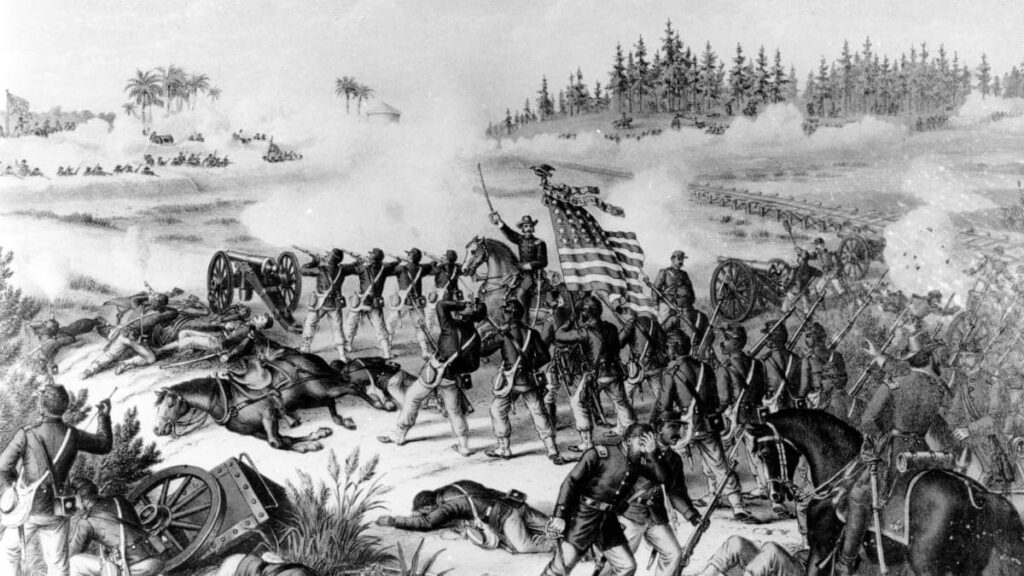At the onset of 1861, Florida declared its separation from the Union. The United States Army Officers assigned to Pensacola and Key West acted swiftly, ensuring that two crucial forts in Florida would not fall into Confederate hands. Fort Pickens near Pensacola and Fort Taylor in Key West, in tandem with Fort Jefferson in the Dry Tortugas, would become the Union’s vital posts in the deepest part of the South.
Strategic Outposts and Contention
During the war’s tenure, the Union army expanded its dominion over a majority of Florida’s coastal forts and towns. Florida’s experience of the Civil War contrasted with the intense battles seen in other Southern regions, as the state encountered relatively little large-scale conflict. Major campaigns were limited, with the outstanding exception of the Olustee campaign and several minor expeditions inland. Generally, the Union army preferred to stay near its forts and occupied cities.
The Life of Union Soldiers in Florida
Union soldiers stationed in some locations, such as St. Augustine, found their duties intriguing due to the site’s historical significance and coastal charm. However, many were posted in remote locations where they had to contend with monotonous routines and battle deadly tropical diseases like yellow fever. Additionally, the soldiers had to put up with a swarm of insects typical to the Floridian climate.
Participation of Diverse Units
Florida welcomed an array of northern units, ranging from the New York Zouaves to the Union Army’s African American regiments. Notably, in the final two years of the war, the participation of African American regiments in Union operations in Florida increased significantly.
Battles and Skirmishes by Union Forces
Aside from their significant contribution to the Olustee campaign, both black and white Union army units serving in different parts of the state saw action in numerous smaller battles. These encounters with southern forces took place at locations including Gainesville, Marianna, Station Number 4 near Cedar Key, Fort Myers, and Natural Bridge. Other parts of the state also witnessed minor skirmishes.
Uniforms of Authority: A Closer Look
A glimpse into the past is offered through the meticulously preserved Union army officer’s frock coat. The coat, a symbol of status and authority, paints a vivid picture of the Civil War era’s fashion and the importance of uniformity in military regalia.
Camp Life of Union Artillery Soldiers
Photographs of Union artillery soldiers encamped in Jacksonville provide invaluable insights into camp life. These photos reveal the camaraderie between soldiers, their living conditions, and the harsh realities they faced away from the battlefield.
Florida’s Role in the Civil War
Despite not being a primary battleground, Florida’s Civil War role was vital due to its strategic forts and coastal towns. The Union’s control of these regions played a significant role in shaping the war’s outcome, despite the limited large-scale fighting within the state.
The Undying Legacy of the Union Army
Photographs, preserved uniforms, and personal accounts of Union soldiers reveal Florida’s Civil War’s lesser-known facets. These offer a profound understanding of the state’s wartime experiences, the contribution of diverse regiments, and the Union Army’s enduring influence on Florida’s history.
Florida in the Civil War: A Comparative Overview
| Aspect | Description |
|---|---|
| Role in the Confederacy | Florida joined the Confederacy in January 1861, becoming the third state to secede from the Union. Its role was primarily as a supplier of goods and materials, including beef, pork, salt, and cotton, crucial for the Confederate forces. |
| Contributions to the War Effort | Despite its small population, Florida contributed significantly to the Confederate war effort by providing over 15,000 troops. These soldiers served in various theaters of the war, and the state was a key source of supplies due to its long coastline, which was beneficial for blockade running. |
| Major Battles/Events | Florida was not the site of many large-scale battles but played a crucial role in smaller engagements and as a strategic location for supplies. Significant battles/events include the Battle of Olustee (February 1864), the largest battle fought in Florida, and numerous skirmishes and raids along the coast and interior, highlighting the state’s strategic importance in the conflict. |
| Impact of the Civil War | The Civil War’s impact on Florida was profound, with economic disruption and a significant toll on its population. The blockade of its ports and the destruction caused by raids and skirmishes led to economic hardships. Post-war, Florida faced the challenges of Reconstruction, altering its social, economic, and political landscape significantly. The emancipation of slaves and the eventual readmission to the Union in 1868 marked a new era for the state. |
Conclusion
Florida’s Civil War narrative veers away from the conventional tales of large-scale battles. Instead, it offers a unique perspective on the less-explored aspects of war, such as the struggles of soldiers stationed at remote outposts, the contributions of diverse units, and the state’s strategic importance to the Union. A close look at Florida’s Civil War history provides a unique lens to understand the broader American socio-political landscape of the era.
